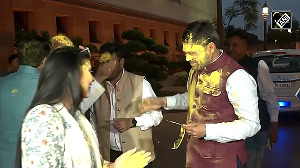A Los Angeles-based think tank has, for the first time in the history of analysis of US-India relations, pointed to the integral role the Indian-American community has played in enhancing ties between the two countries.
The Los-Angeles-based Pacific Council on International Policy, the Western partner of the influential Council on Foreign Relations, in a report in collaboration with the New Delhi-based Observer Research Foundation, argues that 'no factor has contributed more to the shift in perception (of India) than the phenomenal growth of a highly educated and disproportionately affluent Indian American community.'
The report titled India-US Relations: A Vision for the Future, points out that Indian Americans are the fastest growing community within America's ethnic mix. 'With a per capita income estimated at $60,093 (versus the national average of $38,885) and with 58 percent holding a bachelor's degree or higher (versus the national average of 20 percent), Indian Americans are, as a group, better off and better educated than the average American,' the report points out.
The report talks of Indian high-tech entrepreneurs in Silicon Valley who created companies, provided 'employment to thousands of highly skilled American workers and achieved stunning breakthroughs in efficiency.
'If,' says the report, borrowing the quote from tech journalist Michael Lewis, 'there is a smell that defines Silicon Valley, it is the smell of curry.'
The report notes that some of these workers took skills honed in California back to India, where they created Indian versions of Silicon Valley in cities such as Hyderabad and Bangalore.
Pointing to the growing political involvement of the Indian-American community, the report says that during the 2004 election year, 'various Indian-American political action and organizing groups plunged into the political fray -- from municipal councils, to Congressional races, to key positions in government.'
Even as it increased its influence in American politics, says the report, the community has organized itself into powerful political action groups with the express goal of influencing United States' policy toward India.
'The now decade-old Congressional Caucus on India and Indian Americans has the express purpose to 'push the Indian-American community's agenda on the Hill. The efforts of Indian American lobbying groups and these caucuses have resulted in an increased and measurable influence over US foreign policy toward India with regard to a host of issues including immigration, bilateral trade, the lifting of economic sanctions following India's 1998 nuclear tests, terrorism and the protection of Indian Americans and Indian visitors to the United States from harassment and hate crimes following the September 11th attacks.'
The section of the report that deals with the community's role in furthering US-India relations leaves no stone unturned -- not even cultural ones. 'Indian Americans are not only financially successful and politically astute, they are culturally engaged,' the report says. 'Increasingly visible in American mainstream culture, Indian Americans are changing the very definition of 'American' to include a distinctly Indian flavor.'
To buttress that point, the report references a Newsweek magazine feature in 2004 that said South Asians in the United States 'are changing the way we eat, dress, work and play.' 'The ubiquitous presence of 'chai' on coffee-house menus, the emergence of the 'Bhangra' workout craze in California and the smiling face on daily television shows of Indian media personalities such as CNN's Dr Sanjay Gupta have served to de-exoticize a country that for far too long remained more Far Pavilions than Fast Company in the American imagination,' the report argues. It suggests that 'at this beginning stage of the 21st century, Indian film, literature, music, cuisine and live entertainment are becoming vibrantly accessible for the first time to a wide American audience.
'The American news media -- print, broadcast and Internet -- is covering India as never before. In radical contrast to the stories and images of the past, India is now more often portrayed as a technological leader and an emerging world economic and political power. It is possible to read a major American daily newspaper and find a story on India or the achievements of somebody from India in every section from science, to business, to the arts, to current affairs. This is an extraordinary change that is bound to have a profound effect on how Americans see India and Indians.'
The report points out that Americans rarely concern themselves with how India perceives the US, but even that is about to change. 'As India's economic and cultural might grows, as the stake of US-based business and entertainment industries in India increases, and as the Indian American population continues to grow in numbers and influence, American may begin to care about Indian perceptions of the United States.'
Speaking at the release of the report at The Brookings Institution in Washington, DC, Dr Abraham F Lowenthal, president emeritus, PCIP, said the report illustrates the validity of the founding hypothesis of the Pacific Council -- "that it is a quaint and Washington-centric notion to think that the international policy of the United States is made exclusively in this capital city."
"It is made by corporations, by trade unions, by non-government organizations of all kinds, by ethnic associations like TiE (The Indus Entrepreneurs) and others, and this is greatly illustrated in this report.' PCIP Task Force leader and former US ambassador to India Richard Celeste suggested that while the community's growing political engagement is the visible face of its involvement, the real impact the community has had on bilateral ties is more subtle and widespread.
"It is the Indian-American doctors who have treated a member of a family for a serious illness, it is the Indian-American professor in college who taught chemistry or physics or math," Celeste said. "It is increasingly the music, it is the film, it is the Internet itself, which is allowing people to communicate back and forth in ways that hadn't been evident before. It is the result of these relationships, which have nurtured and matured over time to a point where there is a real level of respect and a kind of shared enthusiasm and excitement."
Retired General Ved Prakash Malik, former Chief of Army Staff of the Indian Army and founder-president of the ORF Institute of Security Studies, was present at the release representing ORF Chairman R K Mishra and former Indian ambassador to the US Abid Hussain, who chairs the Joint Task Force on the Indian side. "All the Indians who have come here and studied here and are now part of this vibrant Indian-American community have made a tremendous contribution to relations between the United States and India," General Malik said.
He said if Indian and American societies were closer today, at all levels, then they have ever been, "it is mainly because of this contribution by the Indian-American community."
PCIP President Dr Geoffrey Garrett said the key element of the report, for him, was "the rapid rise of what is sometimes called low politics -- the interactions between Indians and Americans with words such as Bollywood and Bangalore becoming everyday parts of the American lexicon.
"That rapid increase in low politics interactions has created an environment in which the two countries can tackle critical high politics -- security and geopolitical issues such as restructuring of the UN, Kashmir conflict and nuclear power and nuclear weapons in India."
Stephen P Cohen, director of the South Asia Program at Brookings, lauded the report for its quality and "much of the analysis", but said the role of technology as an agent of growth in the bilateral relationship was exaggerated. Technology was important, but so are other things as well, he said, expressing some surprise that while there was a chapter devoted to two million Indian Americans, there was no discussion on the 200 million Indians below the poverty line.
Celeste and General Malik, in their own ways, underlined the point that the key -- and most often overlooked -- element in blossoming bilateral ties was the people-to-people interaction between Indian Americans and the mainstream, and the role the community plays in non-traditional economic areas such as health-care and entertainment.
"This people bridge between our two countries is quite extraordinary," said Celeste. "The connectivity between the US and India is quite remarkable, and a lot of it happens in a way below the policy radar screen. We now meet in this virtual place whenever we choose to do so and of course, that is enriched by the cultural engagement that occurs whether it is Jhumpa Lahiri's books, or whether it is the latest Indian character in a television program, it's mainstream television, it's Bollywood."
General Malik said the report had to some extent deliberately underplayed the strategic side of the equation. "We felt that people to people contacts and the societal contacts that we have are more beneficial and they have a greater and longer-lasting impact."






 © 2025
© 2025